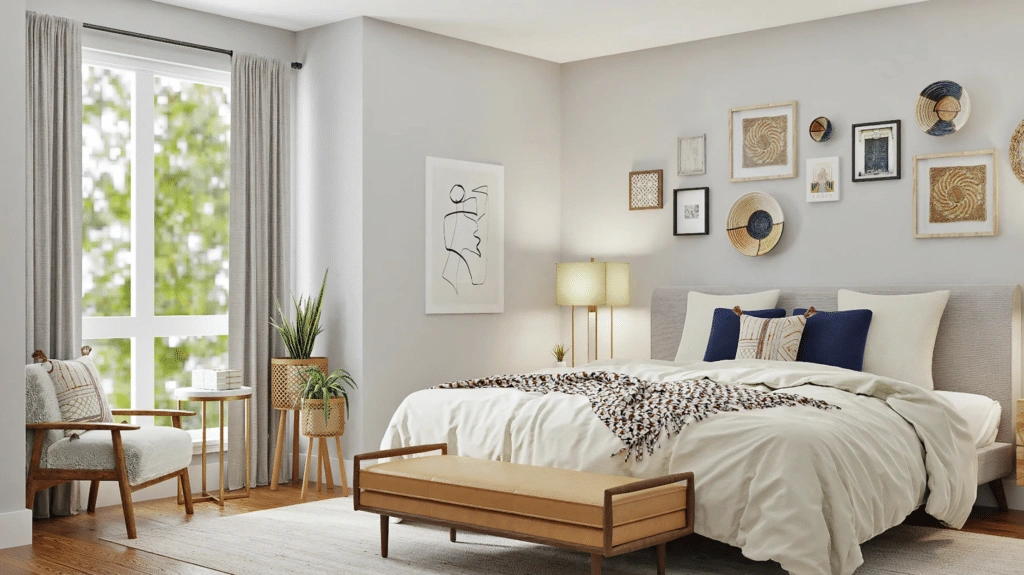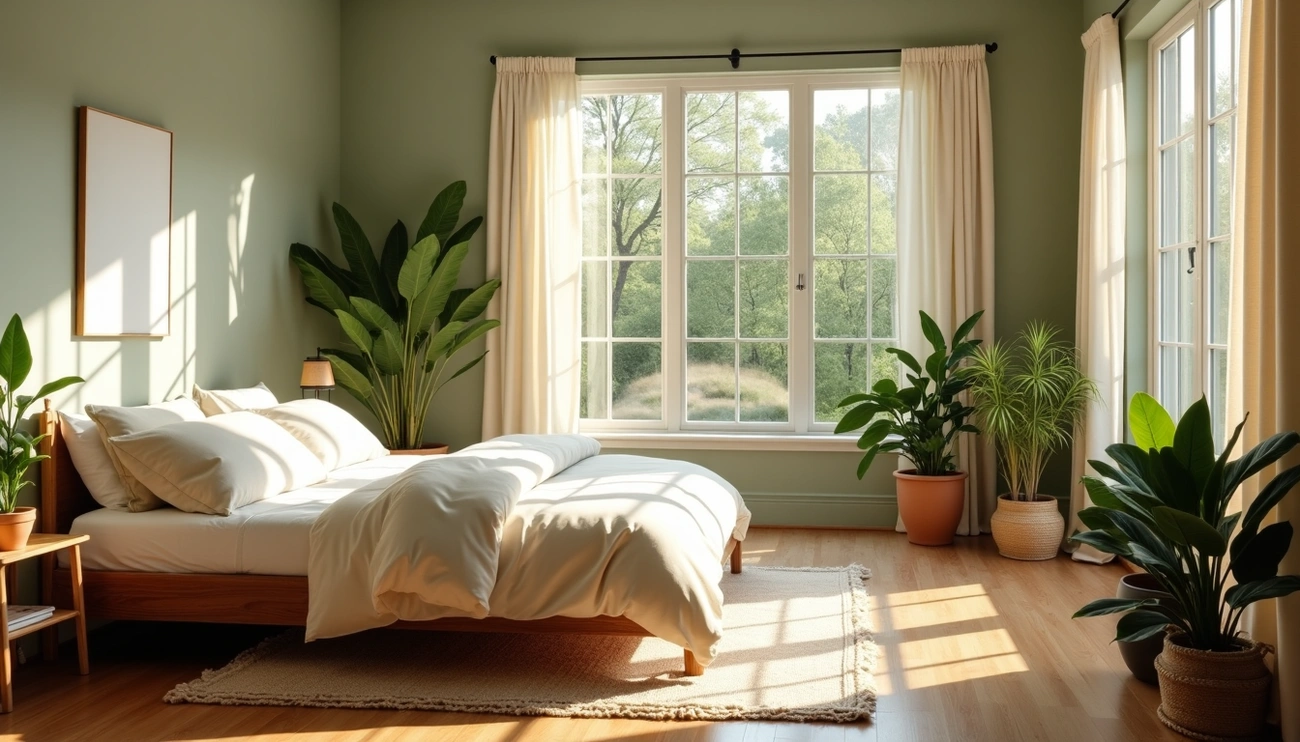Save this article for later
LED bulbs are amazing - they use up to 90% less energy and last 15 times longer than regular incandescent ones. You can start making your bedroom eco-friendly with these simple switches that save you up to £70 yearly and reduce your carbon footprint.
Your bedroom needs to be a natural haven where you can rest and recharge. Many standard bedroom items and products contain volatile organic compounds (VOCs). These chemicals make indoor air quality worse and pose serious health risks. Natural bedroom design goes beyond just looks. You spend about one-third of your life in this space, so it should be healthy and comfortable.
Bamboo furniture stands out as one of nature's most renewable resources. When you combine it with air-cleaning plants like peace lilies and spider plants, you create a stylish and sustainable space. The right temperature matters too. Keeping your bedroom between 60-67 degrees Fahrenheit helps you sleep better and cuts down on energy use.
Click here---> My Best-Find of Air Planter for Natural Air Purifying
This piece shows you practical ways to reshape your bedroom into an eco-conscious sanctuary that's good for you and the planet.
Improve Energy Efficiency in Your Bedroom
Your bedroom's energy consumption mainly depends on how well you manage heat loss. Air leaks near windows and doors waste up to 10% of your yearly energy costs. These small gaps make your heating and cooling systems work harder, so both energy usage and utility bills increase.
Seal windows and doors to prevent heat loss
Check your bedroom windows yearly to find cracks where warm air escapes. You can apply caulk to fixed parts like window frames and add weatherstripping to moving parts such as doors. This easy fix helps create a better sleep environment and reduces drafts. You can cut heating and cooling needs by up to 40% with proper air leak sealing. This makes it the first step to create an eco-friendly bedroom.
Use LED lighting and smart thermostats
ENERGY STAR certified LED bulbs can transform your bedroom's lighting efficiency. These lights need 90% less energy and work 15 times longer than standard bulbs. Each ENERGY STAR certified bulb also stops about 780 pounds of greenhouse gas emissions throughout its life.
Smart thermostats are a great way to cut down energy use. ENERGY STAR certified smart thermostats adjust temperature settings on their own and can lower heating and cooling bills by more than 8%. This saves about $50 each year. Bedrooms in empty homes during the day can save around $100 yearly.
Unplug electronics when not in use
Electronic devices keep drawing power even after you turn them off. This "vampire energy" makes up 5-10% of home energy use. Common bedroom energy vampires include:
- Phone and device chargers (they use power even without charging)
- TVs and entertainment systems
- Heated blankets and humidifiers
You can save $100-$200 yearly by unplugging these devices or using a power strip with an on/off switch. This habit also keeps your electronics safe from power surges and helps them last longer.
You don't need big renovations to create an eco-friendly bedroom. These small, practical changes can substantially reduce your environmental impact and help create a more peaceful sleep space.
Choose Sustainable Furniture and Materials
Purchasing furniture made from recycled or natural materials, or purchasing pre-owned furniture instead of new, is a fantastic way to contribute less waste to our earth." — Realty Executives Integrity, Real estate company specializing in sustainable home solutions
The foundation of an eco-friendly bedroom starts with choosing the right furniture. Recent surveys show 86% of consumers lean towards products that protect plants and animals. This trend shows a rising need for green bedroom solutions.

Check out My Unique Find of Reclaimed Wooden Decor
Opt for reclaimed or FSC-certified wood
Reclaimed wood furniture breathes new life into timber that might end up in landfills. These pieces do more than help the environment - they showcase unique grain patterns that stand out from mass-produced items. The Forest Stewardship Council (FSC) certification will give you peace of mind about responsibly harvested new wood from well-managed forests. A striking 84% of consumers expect companies to sell wood products that protect forests.
Consider bamboo and recycled materials
Bamboo shines as a remarkable sustainable choice for bedroom furniture. This amazing plant grows up to 46 inches in a single day, making it one of our planet's most renewable resources. Traditional hardwoods can't match bamboo's impressive qualities:
- Reaches maturity in just 5-6 years
- Requires no pesticides or fertilizers
- Functions as an excellent carbon sequester
- Proves more durable than solid oak when properly processed
On top of that, furniture made from recycled materials deserves attention. Creative artisans transform upcycled textiles into stunning bedroom accessories. Recycled metal and plastic parts help reduce waste in landfills.
Avoid synthetic finishes and toxic glues
Volatile organic compounds (VOCs) lurk in many standard furniture pieces and add to indoor air pollution. Smart alternatives include furniture with water-based adhesives and non-toxic finishes. You can protect existing pieces with eco-friendly sealants and stains that skip harmful chemicals. Natural wood finishes boost the grain's beauty and create a healthier space for sleep.
Your bedroom's environmental impact extends beyond its walls. Look for furniture makers that embrace responsible manufacturing. Many green furniture brands support environmental causes or help plant new trees. These choices create positive change that reaches far beyond your home.
Upgrade to Eco-Friendly Bedding and Textiles
Your bedding's quality is a vital part of creating an eco-friendly bedroom. You spend about a third of your life in direct contact with these materials. Their composition affects your health and the environment.

15 Best Sustainable Organic Bedding Brands for Better Sleep in 2025
Use organic cotton or hemp sheets
Hemp fabrics stand out in the sustainable world because the plant grows without herbicides or pesticides. This regenerative crop gives back 60-70% of nutrients to the soil. It works as an effective carbon sink and captures greenhouse gasses at twice the rate of forests. You should look for GOTS certified organic hemp with approved dyes. This will give you peace of mind that no harmful chemicals touch your skin.
Organic cotton sheets provide similar benefits and use 91% less water than regular cotton farming. These sheets don't contain formaldehyde (used in wrinkle-resistant treatments) or harsh chemical dyes with heavy metals. They work great for people with allergies or sensitive skin.
Choose natural latex or organic mattresses
Natural latex comes from rubber tree sap and creates a supportive, long-lasting sleep surface. Trees can produce this sustainable material for up to 30 years without damage. The harvesting helps healthy tree growth and remains environmentally responsible.
Certifications are important when buying latex mattresses. The Global Organic Latex Standard (GOLS) ensures mattresses have at least 95% organic latex without toxic chemicals. GOTS certification also guarantees natural wool or cotton covers are truly organic.
Avoid synthetic pillows and duvets
Regular pillows often contain materials soaked in chemicals that you breathe all night. Kapok-latex blend pillows are a better choice. They let you adjust firmness and help align your spine. These natural options usually come with high-standard certifications like GOTS, OEKO-TEX® STANDARD 100, and MADE SAFE®.
Natural fill options like alpaca wool, organic cotton, or silk make excellent duvet choices. These materials regulate temperature better. They keep you cool in summer and warm in winter. Best of all, they biodegrade when their life cycle ends.
Make sure to check for third-party certifications as you upgrade your bedroom. They verify sustainability claims and confirm you're getting genuine eco-friendly products.
Enhance Air Quality and Decor Naturally
"Replacing your bedding with sheets and blankets made from organic materials is another easy switch. Not only are these materials more sustainable, but they can also contribute to the air you breathe, as greener materials grown organically without chemical dyes will lead to less toxic particles in the air in your bedroom." — Realty Executives Integrity, Real estate company specializing in sustainable home solutions
Your bedroom's air quality is a vital part of eco-friendly design. The air inside can be five times more polluted than outside. A natural sleep sanctuary needs more than green materials - it needs elements that clean your air actively.
Add houseplants for air purification
NASA research shows specific plants can remove toxins like formaldehyde, benzene, and trichloroethylene from your indoor air. These natural cleaners absorb pollutants and release oxygen to create healthier air. Your bedroom needs at least one plant per 100 square feet to clean the air effectively. Here are some great air-purifying plants:
- Spider plants (remove 90% of formaldehyde from surrounding air)
- Peace lilies (filter formaldehyde, benzene, trichloroethylene, and ammonia)
- Snake plants (absorb toxins even in low-light conditions)
- English ivy (eliminates benzene and formaldehyde while adding visual interest)

Check out My Best-Find of Air Planter for Natural Air Purifying
Use low-VOC or no-VOC paints
Conventional paints contain Volatile Organic Compounds that release harmful gasses after drying. VOC levels can be two to five times higher inside than outside. Look for zero-VOC paints with 5g/L or less of VOCs to refresh your bedroom walls. The certification should include colorants since VOCs can hide in tinting processes.
Greenguard Gold labels show rigorous emissions testing. Many top brands now offer zero-VOC options without hazardous air pollutants, formaldehyde preservatives, or chemical odors.
Incorporate natural rugs and curtains
Natural fiber rugs from organic cotton, jute, or wool improve indoor air quality by a lot compared to synthetic options. GOTS-certified organic cotton rugs are free from dyes, chemicals, VOCs, latex, and pesticides. These natural materials break down naturally and leave a smaller carbon footprint.
Linen, organic cotton, or hemp make excellent curtain choices. Many green curtain options use natural vegetable dyes from flowers, spices, and minerals. Bedrooms that need light blocking can use OEKO-TEX certified blackout curtains without PFAS and other harmful chemicals.
Conclusion
Making your bedroom eco-friendly brings benefits way beyond just looks. Small changes can help you cut down your environmental footprint and create a healthier space to sleep. Simple steps like sealing windows to keep heat in and switching to LED lights are the quickest ways to save hundreds on your energy bills each year.
Your choice of sustainable furniture reshapes the scene in your bedroom. Bamboo and FSC-certified wood make beautiful, long-lasting alternatives to regular materials. These choices keep harmful chemicals away from where you sleep. On top of that, natural bedding like organic cotton and hemp feels more comfortable and uses fewer resources to make.
Clean air is without doubt vital to healthy sleep. Air-purifying plants and low-VOC paints make your room's air quality better. Spider plants and peace lilies look beautiful and clean toxins from the air, so you can breathe easier while you sleep.
You don't need big renovations or lots of money to create an eco-friendly bedroom. Smart choices about materials, energy use, and air quality turn your space into a natural haven. Every environmentally responsible choice helps both you and the planet. Your bedroom helps you rest and recover - making it eco-friendly lets this happen in perfect balance with nature.
FAQs
Q1. What are some easy ways to make my bedroom more eco-friendly?
Start by improving energy efficiency through LED lighting, sealing windows to prevent heat loss, and unplugging electronics when not in use. Choose sustainable furniture made from materials like bamboo or FSC-certified wood, and opt for organic bedding made from natural fibers like cotton or hemp.
Q2. How can I improve the air quality in my bedroom naturally?
Add air-purifying houseplants like spider plants or peace lilies, which can remove toxins from the air. Use low-VOC or no-VOC paints when refreshing your walls, and incorporate natural fiber rugs and curtains made from organic materials to reduce indoor pollutants.
Q3. What should I look for when buying an eco-friendly mattress?
Look for mattresses made from natural latex, which is harvested sustainably from rubber trees. Seek certifications like the Global Organic Latex Standard (GOLS) or Global Organic Textile Standard (GOTS) to ensure the materials are genuinely organic and free from toxic chemicals.
Q4. Are there sustainable alternatives to traditional bedroom furniture?
Yes, consider furniture made from reclaimed wood, which gives new life to existing materials. Bamboo is another excellent option as it's highly renewable and durable. Look for pieces with non-toxic finishes and water-based adhesives to further reduce environmental impact.
Q5. How can I make my bedroom more energy-efficient?
Install a smart thermostat to automatically adjust temperature settings, potentially saving on heating and cooling costs. Use LED bulbs, which consume up to 90% less energy than traditional incandescent bulbs. Seal any air leaks around windows and doors to prevent heat loss and improve overall energy efficiency.

